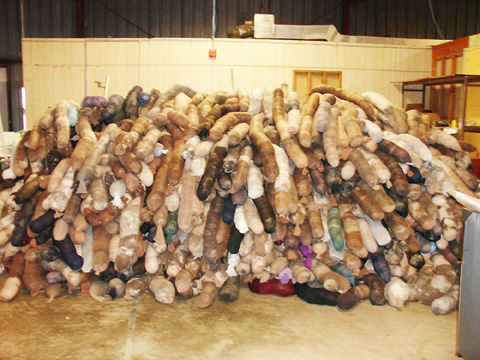Chesapeake Bay's Independent Newspaper ~ Since 1993
1629 Forest Drive, Annapolis, MD 21403 ~ 410-626-9888
Volume xviii, Issue 21 ~ May 27 to June 2, 2010
Home \\ Correspondence \\ from the Editor \\ Submit a Letter \\ Classifieds \\ Contact Us
Best of the Bay \\ Dining Guide \\ Home & Garden Guide \\ Archives \\ Distribution \\ Advertising![]()


Three-Dozen Windmills Blow Renewable Energy to Calvert
But the grid has long tentacles
On May 4, three-dozen windmills in southern Pennsylvania started blowing electricity to Calvert Countians who pay their utility bills to the Southern Maryland Electric Cooperative. That’s 30,000 households, including everybody in the county except citizens of Chesapeake Beach and North Beach.
The Stony Creek windmills sell SMECO and Calvert countians only a tiny percentage of their energy: 20 megawatts. That’s not much, but it’s 1.6 percent of the three percent renewable-source energy that SMECO — like all Maryland utilities — is obligated to buy under state law. The huge bulk, 97 percent, of SMECO’s energy portfolio comes from fossil-fueled and nuclear plants, the dominant energy-generators around the country.
The other 1.4 percent of green energy comes from renewable energy credits that support providers of renewable energy. Those credits help get wind and solar power up and working, but they don’t put energy from those sources on the lines powering SMECO.
“When we invest in renewable credits or pay compliance fees,” explains SMECO spokesman Tom Dennison, “essentially it’s like paying interest on your credit card. You’re not getting tangibles.”
Stony Creek Wind, on the other hand, is hooked right in.
“What we really like about this contract is its infrastructure in the ground,” Dennison told Bay Weekly. “It’s a working facility that is producing renewable energy right now. It’s something tangible we can grab onto.”
Stony Creek Wind has its windmills near Somerset, Pennsylvania. But it’s no friendly almost-neighborhood business. Stony Creek Wind is owned by and operated by a subsidiary of E.On Climate and Renewables. Parent E.On is one of the world’s biggest utilities. Based in Germany, it holds power-generating sources around the world, including a Russian natural gas field.
–Sandra Olivetti Martin
 Well-Deserved
Well-Deserved
Wellness House earns the Annapolis Rotary’s respect and funds
Wellness House of Annapolis celebrates black ties and diamonds this week. Rotary Club of Annapolis donated the record-breaking proceeds of the annual Black Tie and Diamonds gala to the center, which provides cancer patients and their families with solace during difficult times.
This year, the Rotary’s donation was as large as the novelty check: $94,000 earned in the space of one event. Known for its crab feast, which draws thousands of crustacean cravers and typically earns up to $70,000, the Rotary of Annapolis found that this year’s annual gala earned an unprecedented amount, besting the beloved crab feast by more than $2,400.
“That’s the most money we’ve made at a single event,” says Rotary publicity chair Mary Felter. “More than the crab feast.”
There was plenty of competition for the windfall as well, reports Felter. The Rotary of Annapolis accepts grant applications and votes on each charity or cause as a club.
“For this particular event we get as many as five to eight applications,” says Felter. “Whereas for the crab feast we get up to 60.” With the record-breaking donation, charities may reprioritize their grant applications.
The charity caught the Rotary of Annapolis’ attention when it applied for the grant last year. At the time, the group didn’t want to risk funds on a new, untested charitable organization.
Wellness House “has an infrastructure now,” Felter says. “The thing that really appealed to us was that it provides a shelter for adults and kids going through cancer. The counseling for children really attracted us. When children see other children going through what they’re going through, it’s life affirming to them and they know they’re not alone.”
With this financial windfall, Wellness House will make sure that even more children find a source of comfort during difficult times.
“We’re using the grant for a lot of different things,” says treasurer and executive director Jeff McKnight. “The primary grant objective was for CLIMB, for Children’s Lives Include Moments of Bravery.”
CLIMB offers kids ages six to 12 with loved ones fighting cancer support group meetings that help them reconcile their anxiety by meeting other children with similar problems and giving a voice to their fears.
The fame this donation earns Wellness House is as important as the money.
“I think the important thing is we’re trying to get the community to know who we are,” says McKnight. “We’re here for anybody whose family is going through the scourge of cancer.”
To find out more on Wellness House of Annapolis: 410-990-0941; www.annapoliswellnesshouse.com.
–Diana Beechener
Bogged Down?
That’s a plus at Calverton School, which built a bog
to slow runoff
As students prepare to finish their school year, they’re more likely to be studying for exams or making vacation plans. Ecology isn’t normally of great concern. Not so at The Calverton School, where students helped to landscape a bog, a wetland with acidic groundwater, as part of the independent school’s initiative to become more environmentally friendly.
Calverton’s bog is made up of seven ponds separated by rock dams. Water is purified as it flows over rocks and boulders on its way from pond to pond.
“We built the bog to help slow the runoff water coming in from Route 2/4,” said headmaster Dan Hildebrand, who oversees a school of 400-plus students at the bottom of a large hill. Erosion threatens not only the property but also local waterways — from Sewell Branch to Hunting Creek to the Patuxent River to the Bay.
The Cedar Bog, named for its dominant tree, is Calvert County’s first converted, water-retention bog.
Returning from spring break, students found the bog replacing an undeveloped tract just off the road. Many of the students spent Earth Day working on the bog. They mulched the newly bogged stretch of land near the school’s playground, planting over 200 indigenous trees, shrubs and plants chosen to replicate pre-colonial conditions.
Eventually, paths will bring visitors to the bog.
Beyond saving the Bay and bringing people closer to nature, the bog has another job. It gives Calverton an outdoor classroom suited to its learning style, which puts students in the middle of their subjects, not observing them through textbooks.
The Cedar Bog was built with the help of Underwood & Associates, who began the groundwork and architecture of the project, and a grant from the Chesapeake Bay Trust.
See Cedar Bog at its dedication at 11am on June 10: 301-855-8753; Calvertonschool.org.
–Daniel Manning
 This Week’s Creature Feature
This Week’s Creature Feature
Furry Fido can help save the Gulf Coast
Look around your home. Do you see fine feline or canine hairs coating the couch, the floor or your clothes? Before you break out the lint roller, consider that all that excess animal hair in your living room could be floating on the Gulf of Mexico, absorbing harmful oil.
Hair — from humans and animals — is woven or stuffed into sponge-like mats and booms that are flung onto the oil spill. The hairy barriers are laid near shores and marshes, helping to protect these fragile ecosystems from the ravages of the spill.
Local salons and charities have been requesting that good Samaritans donate their hair to help absorb the oil seeping toward the gulf coast. While human hair does absorb oil, many humans are loath to part with their locks.
That’s where pet hair comes in.
California charity Matter of Trust requests that you send them bags of household sundries — from pet fur to fleece to feathers to nylons — so that they can construct hair-booms and hair-mats that float the gulf coast absorbing harmful oil.
Before you shave your pet for charity, take a look at their requirements: at the moment Matter of Trust is at capacity for storing pet hair and nylon and asks that willing donators collect a box of natural fibers, which will be needed in the coming months. So far, the charity has seen donations from Japan, the U.K. and all over the United States.
Locally, former Annapolis mayor Ellen Moyer is hoping to organize an Annapolitan pet hair collection branch for hometown donations.
“Every day I hear people feeling helpless,” Moyer said about the oil spill. “There’s not too much we can do as individuals to make a difference. Collecting hair is something we can do to protect the wetlands, even if it’s not for this oil spill.”
Hair booms and mats would be useful to our Bay even after the Gulf of Mexico is cleaned, according to Moyer.
“I would suspect that the mats could be used in fragile type places near storm drains,” says Moyer, who believes that the mats would absorb oil and other toxic products that often seep into the Bay. “So it would seem to me that this is a simple way to volunteer and help.”
But for now, Moyer is a woman with a plan that needs a warehouse.
“To organize for a collection here, there needs to be a warehouse component,” she says. “If someone steps forward with a warehouse, then I’m willing to partner with them and do some of the legwork.”
To make a difference, keep a grocery bag nearby the next time you brush your dog. Put all excess hair in the bag and store it , checking with the website for donation requests. If you take your pet to a groomer, ask if the company donates the fur.
While Matter of Trust has plenty of hair at the moment, it still needs dollars. Donate funds to the charity so that it can continue to create new booms and transport them to the Gulf Coast. Your pet’s fur is rapidly becoming the coast’s last line of protection.
For more information and donation procedures: www.matteroftrust.org.
–Diana Beechener
© COPYRIGHT 2010 by New Bay Enterprises, Inc. All rights reserved.
